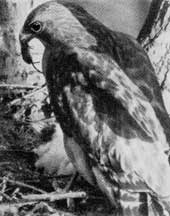Red Shoulders and the Camera's Eye, Page 3
By ALFRED M. BAILEY
Winds that made my aerial blind sway to and fro and downpours of rain prevented further photographic work for five days, and then on May 4 I again climbed the tree of the blind. And good news awaited me. The old one had flushed as wildly as usual, but as my head came on the level of the nest, I saw half a cottontail rabbit decorating the edge. I saw three eggs still unhatched, and then-like a jack-in-the-box, up popped the fuzzy, white head of a youngster. On this day the old one returned in twenty minutes, but overhanging clouds made it impossible to photograph for over an hour. During this time the parent eyed the blind unblinkingly, but when light conditions were right I aimed the camera upon the nest and waved my hand from the slit in the canvas. The bird jumped to her feet, and with tail spread, wings drooped, and head erect, shrieked her defiance. It was as beautiful a picture of a bird denoting power and grace as I have ever seen. She was not afraid-she was merely angry, and she took no pains to conceal her wrath. When she once more settled upon her nest she refused to budge, even though I shook the blind and called loudly. Finally, I tossed my hat in the air. The hawk spread her wings out over the nest and, looking down toward the ground, cursed heartily in raptorian language. When my gaze followed hers I sympathized with her fully, for my cap had lodged in the nesting tree, twelve feet under the nest!

FRESH MEAT FOR THE HUNGRY
She again settled upon her eggs and no amount of effort would make her move, so I pulled the blind aside and we eyed each other. She refused to fly even then, so I felt that she deserved to be alone with her brood, and I climbed down from my polished perch and left her.
A brief visit the next day showed another youngster in the nest-and the two eggs missing. The light was too poor for photographing, but I merely wanted to observe for my notes. A week later I again entered the blind. The woods were now green, and violets and anemones were giving color below; and as the green of the foliage increased, the hawks massed more green upon their nest. I was sorry to see that tragedy had occurred in my hawk family, for only one of the young now remained in the nest. Whether Lonesome Willie, as we named the survivor, had kicked his little brother out, or another type of accident had occurred we were unable to tell, but Willie served us well in the following weeks as we photographed him and recorded his growth. Occasionally the old one would fly to the nest with a writhing garter snake grasped in her talons, and again she would alight with a field mouse held in her strong beak. The adult would no longer pose for her picture, as the camera whirred within a few feet of her; she would come in, stand for a moment, and then take wing. We took pictures of Willie until he was four weeks old, and then we had to leave him to his parents' care.
The woods were now a mass of green and the shrubs and fields were luxurious growths. Soon Willie would be able to shift for himself; and we left him with the hope that he would be able to find a mate and help populate and beautify some stretch of northern woodland.
 Printer-friendly version
Printer-friendly version
